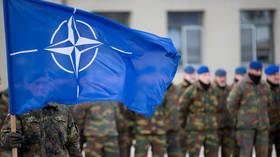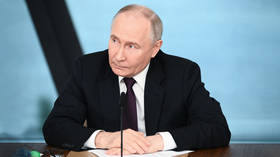Fyodor Lukyanov: This is the only way to end confrontation between Russia and the West
Moscow joined the NATO’s Partnership for Peace program 30 years ago, but today there is neither partnership nor peace
Russia’s then Minister of Foreign Affairs Andrey Kozyrev signed up to NATO’s Partnership for Peace program in Brussels on June 22, 1994. This marked the beginning of official relations between the Russian Federation and the US-led bloc (prior to that, the USSR and NATO were involved in political dialogue within the framework of the North Atlantic Cooperation Council, but it was established only several days before the dissolution of the Soviet Union).
The history of cooperation between Russia and NATO was quite rich and interesting. Over the years, we saw a strange mix of good intentions, political hypocrisy, and mutual misunderstandings which sometimes arose naturally and at other times were deliberate. Experts often talk about unrealized opportunities between the two sides, but this is debatable. In fact, there was never a real chance to establish a true partnership between Russia and NATO, although at some point there were certain illusions regarding this.
The Partnership for Peace program originally served a double goal: it was an alternative to NATO membership, but also a preparatory step for joining the organisation (at least for some countries). When the program was launched, a final decision on the expansion of NATO had not yet been made. Discussions in Washington continued, but the scales generally tipped in favor of spreading its tentacles.
Russia opposed the idea, but was not consistent. Kozyrev warned about the consequences of expansion, but repeatedly said NATO was not Russia’s enemy. Russian President Boris Yeltsin dissuaded Western leaders from growing the bloc, but at the same time told Polish President Lech Walesa that Moscow was not against Warsaw’s accession. At the time, the Partnership for Peace initiative looked like a life-saving compromise. However, two years later, NATO finally announced that it would admit the first group of former communist countries.
Currently, the prevailing view in Russia is that, following the dissolution of the USSR, the US and its allies embarked on a course of a military and political takeover of the former Soviet sphere of influence, and NATO became the main instrument in achieving this. Although this is what eventually happened, the initial motivation might not have been that straightforward. The West’s easy and unexpected success in the Cold War created a feeling of unconditional victory – a political and economic success, but most importantly, a moral one.
The West felt that, as the winning side, it had the right to determine the structure of Europe and knew exactly how to go about it. This was not simply a display of conscious arrogance, but rather of joyful euphoria. It seemed that, from now on, things would always be like this.
The concept adopted at the end of the Cold War stated that NATO ensured European security, and a bigger NATO meant a more secure continent. As a first step towards this, everyone (including Moscow) agreed that a reunited Germany would remain a member of the bloc instead of receiving neutral status, as some had suggested earlier. Further, it was implied that each country had the right to choose whether or not to join any alliances. Theoretically, that is what sovereignty implies. But in practice, the geopolitical balance of power had always imposed restrictions that forced alliances to consider the reaction of non-member countries. However, the triumphalism that reigned in the West following the Cold War significantly reduced the willingness to take such reactions into account. In other words, NATO felt like it could do anything and no reply would follow.
The situation could have changed dramatically if Russia had considered the possibility of joining NATO, and if the bloc itself had considered such a scenario. Then the principle of the indivisibility of security, proclaimed in the 1990 Charter of Paris for a New Europe, would have been respected within the framework of the bloc. However, it was impossible for Russia to join NATO, since, even at its weakest, Russia remained one of the world’s largest military powers and possessed the largest nuclear arsenal. The hypothetical accession of such a state to NATO would mean the emergence of a second force within the club that would be on a par with the US, and therefore, would not obey it on the same level as other allies. This would change the very essence of the organization, and alter its principles of Atlanticism (simply because of Russia’s geographical location). No one was prepared for this. The qualitative transformation of NATO was never on the agenda.
As a result, NATO’s expansion, which in a sense became automated, pushed Russia further and further to the east. Moscow’s attempts to regulate this process – first through participation in joint institutions (such as the NATO-Russia Council of 2002, which was an expansion of the NATO-Russia Founding Act of 1997) and then through growing opposition (starting with Putin’s Munich Speech in 2007) – did not bring the desired results. In addition to the inertia of the West’s initial approach (which implied that the bloc’s very existence is security in itself), the West believed that Moscow didn’t have the right to set conditions and must only follow the rules set by the stronger and more successful Western community. This is how the EU eventually got involved in the current Ukraine war.
Could relations between NATO and Russia have developed in a different way? The West believes that the persistence of Russia, which continued to consider NATO a threat to its security, led to the current military crisis. And, in fact, this became a self-fulfilling prophecy. But even assuming that this was true, the speed and ease with which NATO returned to a strong confrontation with Russia shows that it had been prepared for this.
Russia’s memorandum of December 2021 and the 2022 military operation in Ukraine were designed to put an end to the idea of NATO’s uncontested expansion as the only means of ensuring European security. Two-and-a-half years later, we see that the scale of the conflict has exceeded all initial expectations. Judging by Moscow’s statements, the confrontation may only come to an end when the principles on which European security is based are fundamentally reconsidered.
This is not a territorial conflict, but a conflict which may only end when NATO abandons its main goal and function. So far, there is no compromise on the horizon. The Western side is not willing to agree that the results of the Cold War must be reconsidered, and the Russian side is not ready to retreat without this assurance. Thirty years after the signing of the Partnership for Peace program, there’s still no partnership or peace between Russia and NATO. And neither is there a clear understanding of why the two sides were unable to achieve it.







Comments are closed.